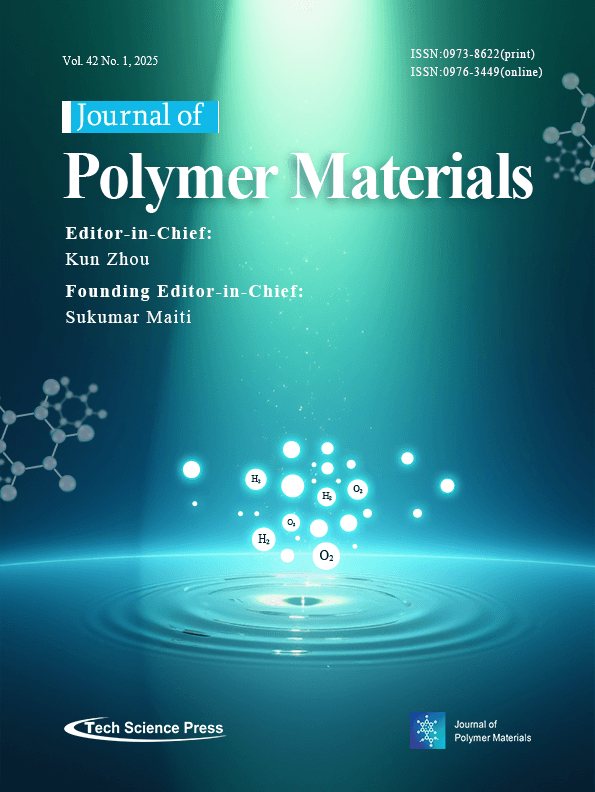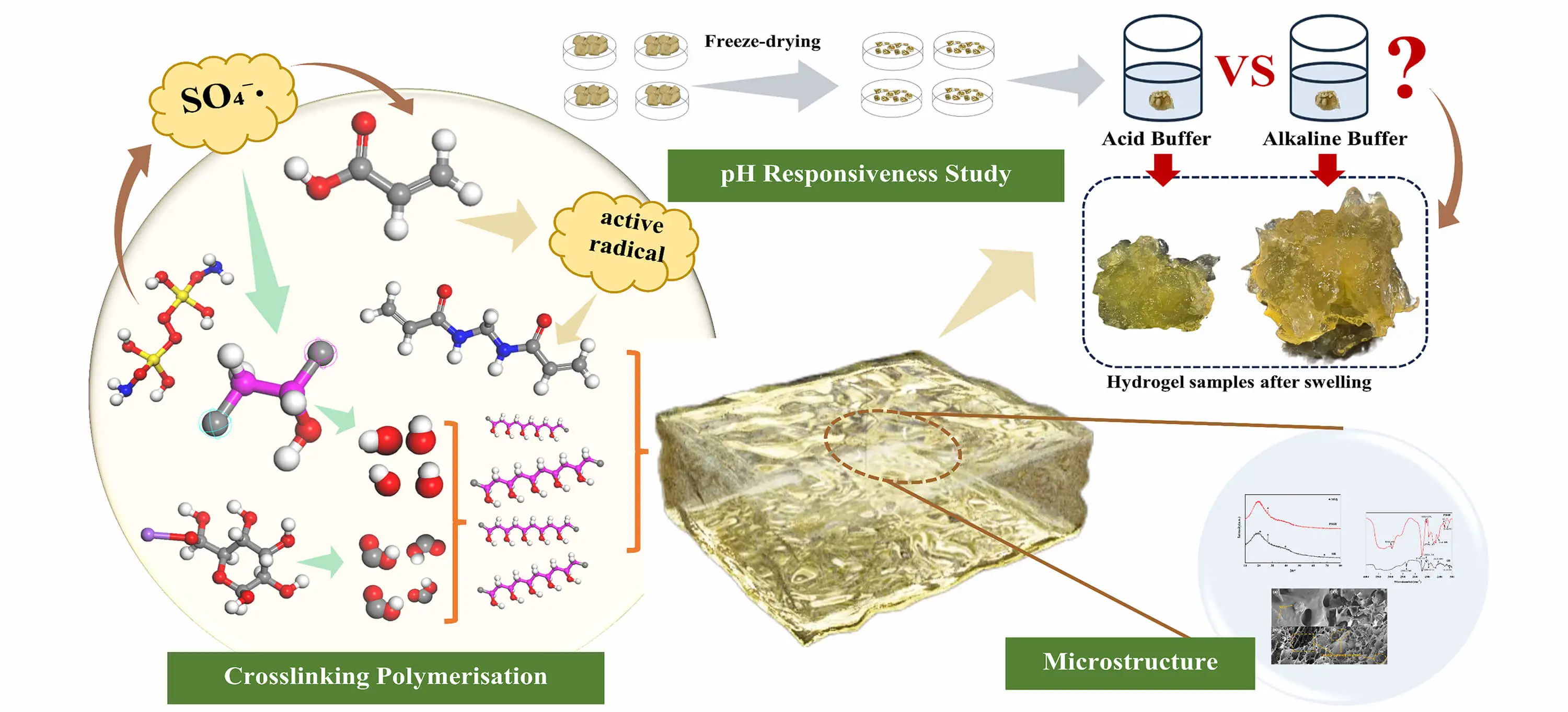
Journal of Polymer Materials is published quarterly (4 issues per year), which covers broadly most of the important and fundamental areas of Polymer Science and Technology. It reports reviews on current topics and original research results on synthesis of monomers and polymers, polymer analysis, characterization and testing, properties of polymers, structure-property relation, polymer processing and fabrication, and polymer applications. Research and development activities on functional polymers, polymer blends and alloys, composites and nanocomposites, paints and surface coatings, rubbers and elastomeric materials, and adhesives are also published.
Science Citation Index Expanded (SCIE): 2023 Impact Factor 0.3; EBSCO; ProQuest; Genamics (JournalSeek); Chemical Abstracts Service (CAS); National Academy of Agricultural Sciences (NAAS); Indian Citation Index.
 Open Access
Open Access
REVIEW
Journal of Polymer Materials, Vol.42, No.1, pp. 1-31, 2025, DOI:10.32604/jpm.2025.058936 - 27 March 2025
Abstract Photocatalysis is a crucial technique for environmental cleanup and renewable energy generation. Polymer-based photocatalysts have attracted interest due to their adaptability, adjustable chemical characteristics, and enhanced light absorption efficiency. Unlike traditional inorganic photocatalysts, we can optimize polymeric systems to enhance photocatalytic efficiency and yield significant advantages in environmental remediation and energy conversion applications. This study talks about the latest developments in polymer-based photocatalysts and how important they are for cleaning water, breaking down pollutants, and making renewable energy through processes like hydrogen production and CO2 reduction. These materials are proficient in degrading harmful pollutants such as… More >
 Open Access
Open Access
REVIEW
Journal of Polymer Materials, Vol.42, No.1, pp. 33-55, 2025, DOI:10.32604/jpm.2025.062352 - 27 March 2025
(This article belongs to the Special Issue: Grafting to and from Polymer Nanocomposites blends for Coating, Energy and Environmental Applications)
Abstract The thermal stability of lithium-ion battery separators is a critical determinant of battery safety and performance, especially in the context of rapidly expanding applications in electric vehicles and energy storage systems. While traditional polyolefin separators (PP/PE) dominate the market due to their cost-effectiveness and mechanical robustness, their inherent poor thermal stability poses significant safety risks under high-temperature conditions. This review provides a comprehensive analysis of recent advancements in enhancing separator thermal stability through coating materials (metal, ceramic, inorganic) and novel high-temperature-resistant polymers (e.g., PVDF copolymers, PI, PAN). Notably, we critically evaluate the trade-offs between thermal… More >
 Open Access
Open Access
REVIEW
Journal of Polymer Materials, Vol.42, No.1, pp. 57-80, 2025, DOI:10.32604/jpm.2025.060401 - 27 March 2025
(This article belongs to the Special Issue: Advances in Functional Polymer Composites: Synthesis, Characterization and Applications)
Abstract Proton exchange membrane fuel cells (PEMFCs) have gained increasing interests as promising power sources due to their ability to convert hydrogen and oxygen directly into electricity with high efficiency and zero greenhouse gas emissions. Bipolar plates (BPs) are considered as a critical component of PEMFCs, serving to collect current, separate gases, distribute the flow field, and conduct heat. This paper reviews the technical status and advancements in BP materials, with special focus on strategies for enhancing interfacial contact resistance (ICR) and corrosion resistance through conductive polymer (CP) coatings. First, commonly used BP materials in PEMFCs More >
 Open Access
Open Access
ARTICLE
Journal of Polymer Materials, Vol.42, No.1, pp. 81-94, 2025, DOI:10.32604/jpm.2025.061047 - 27 March 2025
(This article belongs to the Special Issue: Advances in Functional Polymer Composites: Synthesis, Characterization and Applications)
Abstract This paper presents the development of a thermoplastic shape memory rubber that can be programmed at human body temperature for comfortable fitting applications. We hybridized commercially available thermoplastic rubber (TPR) used in the footwear industry with un-crosslinked polycaprolactone (PCL) to create two samples, namely TP6040 and TP7030. The shape memory behavior, elasticity, and thermo-mechanical response of these rubbers were systematically investigated. The experimental results demonstrated outstanding shape memory performance, with both samples achieving shape fixity ratios (Rf) and shape recovery ratios (Rr) exceeding 94%. TP6040 exhibited a fitting time of 80 s at body temperature (37°C), More >
 Open Access
Open Access
ARTICLE
Journal of Polymer Materials, Vol.42, No.1, pp. 95-110, 2025, DOI:10.32604/jpm.2025.059364 - 27 March 2025
Abstract The continuous improvement in patient care and recovery is driving the development of innovative materials for medical applications. Medical sutures, essential for securing implants and closing deep wounds, have evolved to incorporate smart materials capable of responding to various stimuli. This study explores the potential of thermoresponsive sutures, made from shape memory materials, that contract upon heating to bring loose stitches closer together, promoting optimal wound closure. We developed nanocomposites based on a blend of poly(lactic acid) (PLA) and thermoplastic polyurethane (TPU)—biopolymers that inherently exhibit shape memory—enhanced with carbon nanotubes (CNT) and graphene nanoplatelets (GN)… More >
 Open Access
Open Access
ARTICLE
Journal of Polymer Materials, Vol.42, No.1, pp. 111-123, 2025, DOI:10.32604/jpm.2024.057957 - 27 March 2025
(This article belongs to the Special Issue: Multifunctional Conductive Hydrogels and Their Applications)
Abstract Flexible electrochromic devices (FECDs) demonstrate significant potential for applications in wearable electronics, military camouflage, and flexible smart displays. As a crucial electrochromic material, poly(3,4-ethylenedioxythiophene):polystyrene sulfonate (PEDOT:PSS) is widely used in FECDs due to its excellent mechanical flexibility, tunable conductivity, and non-toxicity. However, the manufacturing process for patterned PEDOT:PSS electrochromic devices remains intricate, costly, and challenging to personalize. To address this challenge, we have developed a 3D-printable ink with controllable rheological properties through a concentration-tuning strategy, enabling programmable, patterned printing of PEDOT-based conductive polymer electrochromic layers. The 3D-printed FECDs exhibit outstanding electrochromic performance, including a high More >
 Open Access
Open Access
ARTICLE
Journal of Polymer Materials, Vol.42, No.1, pp. 125-140, 2025, DOI:10.32604/jpm.2024.059636 - 27 March 2025
Abstract With the rapid development of flexible wearable electronic products, their application fields and demands are increasing, posing new challenges to flexible conductive materials. This paper selected flexible polydimethylsiloxane (PDMS) as the substrate. In order to enhance the adhesion between the substrate and the metal coating, dopamine and silanization were used to co-modify its surface. A conductive layer of metallic copper is deposited on its surface using an inexpensive, easy-to-use electroless plating technique. By optimizing the process conditions, it is found that a uniform copper layer of about 0.6 μm can be formed on the surface More >
 Open Access
Open Access
ARTICLE
Journal of Polymer Materials, Vol.42, No.1, pp. 141-150, 2025, DOI:10.32604/jpm.2024.057423 - 27 March 2025
Abstract Geological samples often contain significant amounts of iron, which, although not typically the target element, can substantially interfere with the analysis of other elements of interest. To mitigate these interferences, amidoxime-based radiation grafted adsorbents have been identified as effective for iron removal. In this study, an amidoxime-functionalized, radiation-grafted adsorbent synthesized from polypropylene waste (PPw-g-AO-10) was employed to remove iron from leached geological samples. The adsorption process was systematically optimized by investigating the effects of pH, contact time, adsorbent dosage, and initial ferric ion concentration. Under optimal conditions—pH 1.4, a contact time of 90 min, and More >
 Open Access
Open Access
ARTICLE
Journal of Polymer Materials, Vol.42, No.1, pp. 151-172, 2025, DOI:10.32604/jpm.2025.060699 - 27 March 2025
Abstract The rapid urbanization underscores the urgency of efficient treatment and resource utilization of municipal sludge for environmental conservation. To address this, a novel pH-responsive dual network polyvinyl alcohol/sodium alginate sludge hydrogel was devised by integrating municipal sludge with acrylic acid monomers, ammonium persulphate initiator, N, N’-methylene bisacrylamide crosslinking agent, reinforced by polyvinyl alcohol and sodium alginate through free radical cross-linking polymerization. The hydrogel’s optimal formulation was identified by adjusting the monomer, crosslinking agent, and initiator dosage while assessing its swelling behavior across various pH environments. Results revealed excellent swelling capacity, notably exhibiting a remarkable swelling More >
Graphic Abstract

 Open Access
Open Access
ARTICLE
Journal of Polymer Materials, Vol.42, No.1, pp. 173-185, 2025, DOI:10.32604/jpm.2025.059244 - 27 March 2025
Abstract This work explores the dielectric and electrochemical properties of solid biopolymer blend electrolytes (SBEs) based on a combination of alginate and polyvinyl alcohol (PVA), doped with varying concentrations of ammonium iodide (NH4I). The SBEs were synthesized using the solution casting method, and their ac conductivity exhibited an optimal value of 1.01 × 10−5 S · cm−1 at 25 wt.% NH4I. Detailed dielectric and modulus spectroscopy analyses revealed distinctive trends in relation to NH4I concentration, suggesting complex dielectric relaxation behavior. The universal power law (UPL) analysis identified the Small Polaron Hopping (SPH) mechanism as the dominant conduction process in More >
 Open Access
Open Access
ARTICLE
Journal of Polymer Materials, Vol.42, No.1, pp. 187-204, 2025, DOI:10.32604/jpm.2025.057322 - 27 March 2025
Abstract Smart materials with self-healing properties are highly desired. This study investigates graphene-incorporated styrene-isoprene-styrene (SIS) nanocomposites for their self-healing property assisted by Infrared (IR) and microwave radiation. The good thermal conductivity and energy-absorbing capacity of graphene offer self-healing capability to SIS/GnP nanocomposites due to their exposure to IR and microwave radiation. The absorbed energy in graphene is transferred to the SIS matrix, facilitating the diffusion, re-entanglement, and restoration of the SIS polymer chains, resulting in multiple times self-healing capabilities using various external stimuli. All SIS/GnP nanocomposite samples exhibit self-healing behavior, and the healing efficiency rises with… More >
Graphic Abstract

 Open Access
Open Access
ARTICLE
Journal of Polymer Materials, Vol.42, No.1, pp. 205-220, 2025, DOI:10.32604/jpm.2025.059697 - 27 March 2025
Abstract This work reports a soft chemistry approach for the synthesis of magnesium oxide nanoparticles (MgO) incorporated in a polyaniline (PANI) matrix to give PANI/MgO nanocomposite. Using spin coating method, three different percentages of MgO/PVC (1, 2, and 3% in wt.%) were deposited on glass substrates. These films of PANI/MgO nanocomposite were characterized by X-ray diffraction (XRD), atomic force microscopy (AFM), and UV-visible spectroscopy. The results of the XRD pattern revealed the embedding of MgO nanoparticles in the PANI matrix with cubic phase, with the average size of nanoparticles varying from 35.12 to 59.55 nm. The… More >
 Open Access
Open Access
ARTICLE
Journal of Polymer Materials, Vol.42, No.1, pp. 221-236, 2025, DOI:10.32604/jpm.2025.058587 - 27 March 2025
Abstract Acrylonitrile–butadiene–styrene (ABS) is the main material used in fused deposition modeling (FDM), which has good toughness and strength, but the single ABS material has poor heat resistance, which tends to cause warping and deformation during the printing process. Polycarbonate (PC) exhibits good performance in heat resistance, allowing it to maintain stable performance at higher temperatures. In this work, PC was used as a blending modifier to prepare five kinds of ABS/PC composite filaments, and the mechanical and thermal properties of the ABS/PC (Acrylonitrile–butadiene–styrene/Polycarbonate) composite filaments were studied and analyzed. Results showed that the glass transition… More >
 Open Access
Open Access
ARTICLE
Journal of Polymer Materials, Vol.42, No.1, pp. 237-253, 2025, DOI:10.32604/jpm.2025.059622 - 27 March 2025
Abstract In this manuscript, we conveniently prepared a series of polyester-polycarbonate copolymer (PPC-P)/polybutylene adipate terephthalate (PBAT) blends that exhibit both flame-retardant properties and toughness. Piperazine pyrophosphate (PAPP), melamine phosphate (MPP) and ZnO were used as synergistic flame retardants for PPC-P/PBAT blends. The effects of synergistic flame retardants on thermal stability, combustion behavior and flame retardancy of PPC-P/PBAT blends were investigated. The results showed that when the ratio of PAPP/MPP/ZnO was 18.4:9.2:2.4, the LOI of PPC-P/PBAT composite was 42.8%, and UL-94 reached V-0 level. The results of cone calorimetry showed that the mass loss rate (MLR), the… More >
 Open Access
Open Access
ARTICLE
Journal of Polymer Materials, Vol.42, No.1, pp. 255-275, 2025, DOI:10.32604/jpm.2025.062081 - 27 March 2025
Abstract The ongoing operation of subway systems makes existing tunnels vulnerable to deformations and structural damage caused by adjacent foundation pit construction. Such deformations-manifesting as horizontal displacement, heightened lateral convergence, and internal force redistribution-may significantly compromise subway operational safety. Grouting remediation has become a widely adopted solution for tunnel deformation control and structural reinforcement. Developing optimized grouting materials is crucial for improving remediation effectiveness, ensuring structural integrity, and maintaining uninterrupted subway operations. This investigation explores the substitution of fine mortar aggregates with 0.1 mm discarded rubber particles at varying concentrations (0%, 3%, 6%, 9%, 12%, and More >